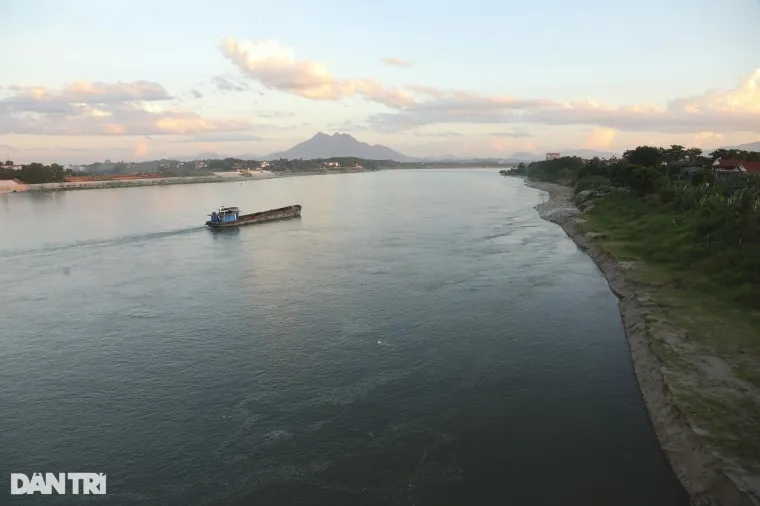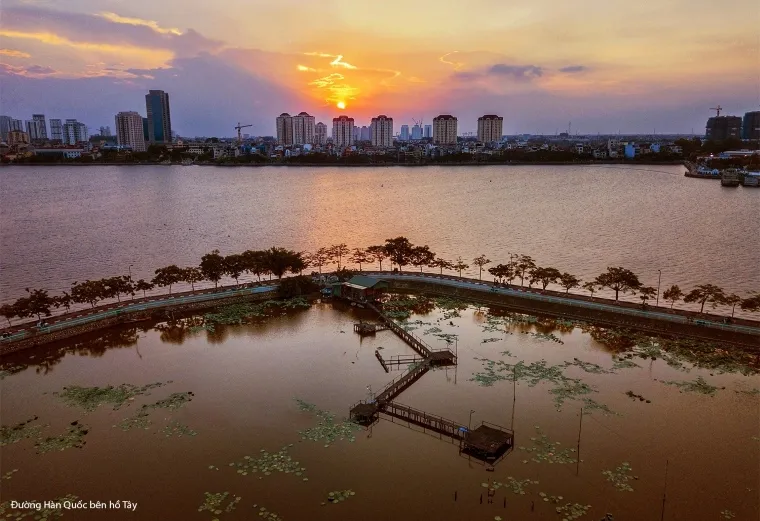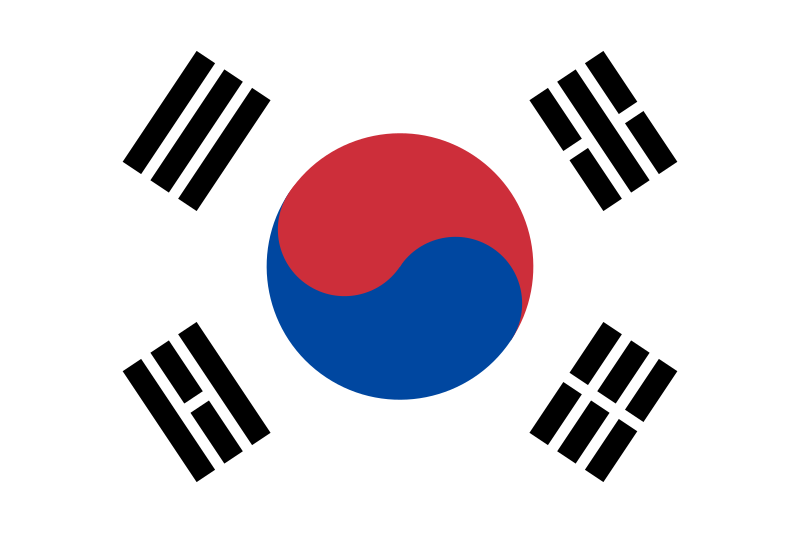Rivers in Hanoi: Flowing Through History, Culture, and Modern City Life
Hanoi, Vietnam's thousand-year-old capital, captivates visitors with its ancient streets, historical monuments, and vibrant urban life. Yet beyond its well-known attractions, such as the bustling 36 streets in Hanoi or The Huc Bridge, lies a less celebrated but equally essential aspect of the city's identity: its intricate network of rivers. These flowing waterways aren't merely geographical features; they're the lifeblood of Hanoi, silently shaping its history, culture, and development for centuries.
From the mighty Red River that defines the city's landscape to smaller waterways like the Tô Lịch that carry centuries of stories, Hanoi's rivers offer travelers a unique perspective on Vietnam's capital. This guide explores the fascinating world of Hanoi's rivers – their historical significance, cultural importance, and how today's visitors can experience these waterways that have nurtured Hanoi's soul for over a millennium.
The River Network: Hanoi's Aquatic Tapestry
Hanoi boasts an intricate system of rivers flowing through and around the city. While sources vary on the exact count—some identify 10 rivers, others mention 7 main rivers plus several urban waterways—there's no question that these waterways form a vital part of Hanoi's geographical identity. The differences in counting often stem from classification criteria (length, flow volume, historical role) or natural and artificial changes to waterways over time.

Hanoi’s rivers are not just natural features but vital elements that reflect the city’s rich history, culture, and urban evolution - Photo Source: Facebook The Forum - Hanoi
Major Rivers of Hanoi
Red River (Sông Hồng): The Mother River
The Red River, stretching 1,149 kilometers from China's Yunnan province, flows for 556 kilometers through Vietnam—163 of which pass through Hanoi. Its winding path embraces the capital from Ba Vi to Gia Lam, shaping the city’s landscape and history.
Known as "Hong Ha" for its silt-laden red waters, the river also carries older names like Song Cai (Mother River) and Nhi Ha, reflecting its nurturing role and distinctive shape. It has long been the backbone of the Red River Delta, fostering Vietnam's ancient rice civilization.
More than just a waterway, the Red River was once vital for trade, linking Thang Long-Hanoi with distant regions. Though its transport role has declined, it remains crucial for agriculture and daily life.
In times of flood, its force demands respect. Dykes like La Thanh were built to protect Hanoi, highlighting the river’s dual nature—both life-giving and potentially destructive. Today, the Red River remains a powerful symbol of Hanoi’s cultural and historical identity, flowing through the city’s past and present.
Duong River (Sông Đuống): The Poetic Tributary
The Duong River, a key distributary of the Red River, stretches about 65–68 kilometers through Hanoi and Bac Ninh before merging with the Thai Binh River system. Originating between Dong Anh and Long Bien, it flows eastward, once known as Thien Duc Giang during the Ly dynasty.
Historically vital for transportation and irrigation, the Duong River was regularly dredged under the Ly, Tran, and Nguyen dynasties—evidence of its strategic importance. Today, it is crossed by several notable bridges, including the historic Duong Bridge and modern Phu Dong Bridge.
While smaller than the Red River, the Duong River holds deep cultural value. It is closely tied to the Kinh Bac cultural region and immortalized in Hoang Cam’s poem The Other Side of Duong River, symbolizing both resilience and poetic beauty. More than a waterway, the Duong River flows through the heart of Vietnam’s historical memory and cultural soul.
To Lich River (Sông Tô Lịch): The Historical Urban Stream
Stretching just 13.5–14 km through Hanoi’s inner districts, the To Lich River bears a name rooted in legend—named after To Lich, a village elder who once led Long Do, ancient Hanoi's first village.
Historically, the river played a key role in Thang Long’s waterway network. Fed by the Thien Phu River and West Lake, it was once full, cool, and clear, forming a natural moat around the ancient citadel. Lively trade boats lined its banks, as reflected in folk songs celebrating its charm.
However, urbanization and historical shifts—including landfills during the French colonial period—cut off the river’s water sources. Today, the To Lich is heavily polluted, receiving around 160,000 m³ of untreated wastewater daily, turning it into a stagnant, lifeless canal.
Despite its decline, the To Lich River remains a powerful symbol in Hanoi’s collective memory. Linked to the city’s origins, it continues to inspire efforts toward environmental restoration and a hope to revive its former vitality.
![]()
The Red, Duong, and To Lich rivers are Hanoi’s most iconic waterways, each carrying deep historical and cultural significance - Photo Source: Báo Dân Trí
Other Significant Rivers
Beyond the three iconic rivers—Red, Duong, and To Lich—Hanoi's network of waterways includes several other significant rivers, each with its own role and characteristics:
Da River (Sông Đà): The largest tributary of the Red River, also originating from China. Known for its treacherous terrain with many rapids and high water volume, it supplies more than 30% of the Red River's water. Nicknamed the "energy river" with a series of large hydroelectric plants like Hoa Binh, Son La, and Lai Chau. The "Da River Clean Water" project plays an important role in supplying drinking water to Hanoi, gradually replacing depleting groundwater sources.
Nhue River (Sông Nhuệ): Flows through western and southern Hanoi, receiving water from the To Lich River at the To Bridge area. The Nhue River plays an important role in the city's drainage system. However, like the To Lich, it faces serious pollution from untreated wastewater.
Day River (Sông Đáy): One of the major rivers in northern Vietnam, flowing through the western edge of Hanoi. It's listed among the city's main rivers and is also affected by pollution.
Cau River (Sông Cầu): Part of the Cau River flows through northern Hanoi. It meets the Thuong River and Duong River at Pha Lai (Luc Dau Giang) before emptying into the Thai Binh River system.
Ca Lo River (Sông Cà Lồ): Flows through the northern suburban areas of Hanoi.
Tich River (Sông Tích): Also called Tich Giang, it's a tributary of the Bui River (part of the Red River system), originating from the Ba Vi range. The Tich River flows through areas with many important historical and cultural relics such as Son Tay ancient citadel, Duong Lam ancient village, and Phung Hung temple.
Kim Nguu River (Sông Kim Ngưu): Another small river flowing through the inner city, often mentioned along with the To Lich River in folk songs and historical records about ancient Thang Long. Currently, Kim Nguu River also suffers from severe pollution.
Thien Phu River (Sông Thiên Phù): Although not a distinct waterway today, the Thien Phu River once played an important role in Hanoi's ancient hydrological system. It originated from the Nhat Tan area, flowed through the Buoi region, connecting West Lake with the To Lich and Nhue Rivers, creating favorable conditions for trade. The disappearance of the Thien Phu River (filled in during the 18th century) significantly affected the flow of the To Lich River. This river is also associated with many local legends.
The diversity of these rivers—from the mighty Da River supplying energy and clean water to the Tich River linked to cultural heritage, or the Thien Phu River that exists only in memory—shows a complex hydrological picture. This network represents not just a natural system but reflects the long-term interaction between humans and the environment, with interventions such as building hydroelectric dams and water supply systems, but also with consequences like pollution and altered waterways.

Hanoi’s many other rivers—from the energy-rich Da to the culturally significant Tich—reveal a diverse and dynamic hydrological system - Photo Source: Báo Dân Trí
Exploring Hanoi's Rivers: Tourism and Recreation
Today, despite facing many environmental challenges, Hanoi's rivers still offer unique experiences for visitors and locals, from river cruises and enjoying riverside cuisine to relaxing in green spaces.
River Cruises and Water Experiences
Traveling by boat on the Red River is an interesting way to view the city from a different angle, immerse yourself in the charming river landscape, and explore destinations along the shore. Boat tours typically include admiring the beauty of bridges, ancient temples and pagodas, observing the life of riverside residents, and especially visiting Bat Trang pottery village. Some tours combine lunch or dinner on board, providing a unique dining experience amid the river scenery. Prices for group tours or private boat charters are quite diverse, suitable for many types of visitors.
Besides the Red River, the potential for cultural-historical tourism along the Duong River has also been proposed, with ideas to connect the dense chain of historical sites on both banks, from Co Loa, Phu Dong to Kinh Bac countryside villages. However, tourism activities on other rivers or more diverse river experiences (such as kayaking, water sports as mentioned for Ho Chi Minh City) don't seem popular or widely documented in Hanoi based on the reference materials.
Riverside Dining
Enjoying cuisine at restaurants along rivers is a popular experience, combining food flavors with spacious, romantic settings. Hanoi has quite many riverside restaurant options, mainly concentrated in areas near the Red River and West Lake:
Long Bien District: This area has many restaurants with spacious settings close to nature such as Nang Song Hong Cultural and Culinary Village (Phu Vien), Huong Que Restaurant (Giang Bien), La Bodega Restaurant (Thach Cau), The Clover Ngoc Thuy (French-style restaurant).
Tay Ho District: Areas near West Lake and the Red River also have notable venues such as Sen Dam Tri Restaurant (Dang Thai Mai), Softwater Restaurant (An Duong) with green, cool spaces. Red River Bamboo Restaurant (Au Co) features Northern Vietnamese countryside style.
Red River Mid-Bank: Thao Vien Gio Song Hong (at the end of alley 76 An Duong) provides outdoor dining space combined with picnicking.
Hoan Kiem District: Toan Thang lang fish restaurant (Bach Dang) has a location near the Red River.
These restaurants serve diverse dishes, from traditional Vietnamese cuisine, local specialties (like lang fish) to European dishes, with prices ranging from affordable to high-end, meeting diverse customer needs.

Hanoi’s rivers offer unique tourism opportunities through boat rides, riverside dining, and green recreational spaces - Photo Source: znews
Riverside Parks and Relaxation Spaces
The Red River alluvial banks have become familiar destinations for Hanoi residents seeking green spaces to relax, play, and take photos.
Red River Rock Bank: Located at the end of alley 264 Au Co (Nhat Tan, Tay Ho), this area is famous for its vibrant flower gardens that change seasonally (daisy, sunflower, peach, chrysanthemum...), attracting many visitors for photography, especially during the daisy season at year-end. Besides the flower garden, the Rock Bank also has photo spots (wooden bridge, swing, vintage cars...), camping areas, picnic areas, Chimi Farm strawberry garden, and cafes like Sixdoong cafe & camping. Entrance tickets and service fees here are quite reasonable.
Red River Mid-Bank: A large space in the middle of the river, accessible from An Duong area (Tay Ho) or Long Bien Bridge. This place has a wild beauty, suitable for outdoor activities, picnics, kite flying, or simply strolling to enjoy the fresh air. Currently, the Mid-Bank is the focus of major planning projects aiming to build a "Multi-functional Cultural Landscape Park," transforming this area into a large-scale public space, connecting central districts (Hoan Kiem, Ba Dinh, Tay Ho) with Long Bien district, exploiting the landscape and cultural potential of the Red River.
Yen So Park: Although not directly located on a major flowing river, Yen So Park (Hoang Mai) with its large area, many trees and lakes, is also an important green space, an ideal location for outdoor activities and picnics for Hanoi residents.
The existence of spontaneous recreational spaces like the Rock Bank, Mid-Bank, along with large-scale park planning projects show the strong need and desire of residents for accessible green spaces and water spaces in the heart of Hanoi. This reflects the general trend of modern cities worldwide in rebuilding and returning riverbanks to communities, not just serving industrial or transportation purposes but also enhancing quality of life and environmental protection.
Visiting Traditional Villages and Riverside Destinations
The journey exploring Hanoi's rivers can be combined with visiting traditional craft villages and cultural-historical sites located along rivers.
Bat Trang Pottery Village: An unmissable destination when mentioning Red River tourism. This ancient village on the left bank of the Red River (in Gia Lam district) is famous for its centuries-old pottery craft. Visitors can come here by road or combine it with a Red River boat tour. At Bat Trang, visitors can tour ancient pottery kilns, learn about the production process, experience pottery making firsthand, and shop for unique ceramic products.
Duong Lam Ancient Village: Located near the Tich River (in Son Tay town), Duong Lam is one of the few ancient villages that still preserves the structure and architecture characteristic of Northern Vietnamese villages with village gates, banyan trees, water wharves, communal house yards, and hundreds-year-old laterite houses.
Hanoi Book Street: For a change of pace, Hanoi Book Street provides a lovely stop for book lovers. Located in the heart of the city, this vibrant street offers a peaceful environment to explore diverse literary collections, enjoy the charm of street-side cafes, and experience Hanoi's unique urban culture. It’s a great way to take a break from river tours and dive into local literature.
Other destinations: Visitors can also explore other ancient villages or relics along rivers or in related tours such as Phu Thi village, temples along the Red River like Ghenh Temple, Co Bo Ben Bac Temple, Rung Temple, or Co Loa Citadel near ancient waterways.
Conclusion: The Enduring Vitality of Hanoi's Rivers
From the mighty Red River carrying heavy alluvium that built the delta civilization, to the poetic Duong River immortalized in poetry, or the solemn To Lich River marking the ancient capital's imprint, Hanoi's river system is an integral part, a lifeblood that has nourished and shaped the thousand-year-old capital. These aren't merely geographical elements but living entities carrying within them the flow of history, culture, and community memory.
This report has outlined the multifaceted picture of Hanoi's rivers: from their foundational role in Thang Long's formation and development, deep presence in beliefs and arts, to tourism and recreational potentials with much room for exploration. However, that picture also cannot lack the dark shades of serious environmental pollution, especially in urban rivers like To Lich, Nhue, Kim Nguu – a painful consequence of urbanization and economic development not yet coupled with environmental protection.
Nevertheless, the vitality of Hanoi's rivers remains persistent and enduring. The city's relentless efforts in environmental improvement, from large-scale wastewater treatment projects like Yen Xa to dredging solutions, water replenishment, embankment, and riverside green space planning, show a strong determination to "revive" these rivers. The vision of a city in harmony with its waterways, where rivers are not just clean and beautiful but become landscape axes, public spaces, and valuable ecological corridors, is gradually taking shape.
The journey to restore life to rivers will certainly be long and challenging. But with their irreplaceable historical-cultural values and essential role for the city's sustainable future, Hanoi's rivers will forever be an important part of the capital's development and identity story – where the flow of water always blends with the heartbeat of the city.
With a well-planned itinerary, budget-friendly options, and an open mind to meeting new people, your solo journey will be both fulfilling and exciting. Let Joytime be your trusted companion, providing essential travel gear to ensure comfort, safety, and convenience throughout your trip. An incredible solo adventure awaits—pack your bags and explore Hanoi with confidence!
|
Joytime - Your Vietnam Journey's Servant Expert Follow us for travel tips, local insights, and exclusive offers:
|














